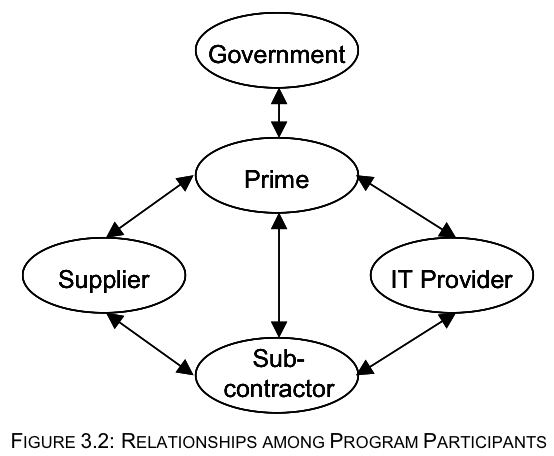DG-BCTF Business Case - Supply Chain Integration Aerospace and Defense
This page is copied from tscp.org "A framework for secure collaboration accross US/UK defense", chapter 3.2 Business Model:
In delivering defense development programs, there are a number of players, including government bodies, contractors and subcontractors, suppliers, and IT providers, with unique capabilities in the development, design, manufacture, and support of defense systems. Figure 3.2 shows the recurring relationships prevalent in the communities formed to address specific defense programs.
These relationships create complex partnerships where competitors in the marketplace and allied nations plan, develop, deploy, operate, and sustain sophisticated defense assets. Due to the complexity of these relationships and the coordination required to achieve program objectives, collaboration among the stakeholder communities is critical for success. This collaboration must be addressed diligently so sensitive data relative to national security, corporate intellectual proprietary, privacy, export control, or other regulations is not disclosed. This data sharing occurs among the participants throughout the program life cycle.
Figure 3.3 shows the UK MOD program life cycle, which is based on Smart Acquisition and DEFSTAN 00-60, and has six stages: concept, assessment, development, manufacture, in service, and disposal; whereas, the US Department of Defense (DoD) Instruction 5000, has five stages: concept & technology development, system development and demonstration, production and deployment, and operations and support. Both the UK and US documents contain similar stages comprised of the entire product development process and the long-term services for support and maintenance.
Within the program life cycle, a review of the activities and services performed to deliver programs by the of defense contractors result in ten major categories for business capabilities.
Each of these business capabilities span different stages of the program life cycle and may be performed by different collaboration participants at the same time.
The business capabilities required from program to program will vary in each defense contractor’s program portfolio. Programs as complex as the Joint Strike Fighter (JSF) may require all ten of the defined categories described earlier, whereas other programs may be exploratory or limited in nature and involve only a handful of business capabilities.
Referring to the design perspective in Figure 3.1, the program manager may review the program scope, the corresponding statement of work, and work breakdown structure to identify the capabilities required to achieve program objectives. The program manager may also consider the agreements between participants to understand the ownership of each of the capabilities and understand who will perform what work.

